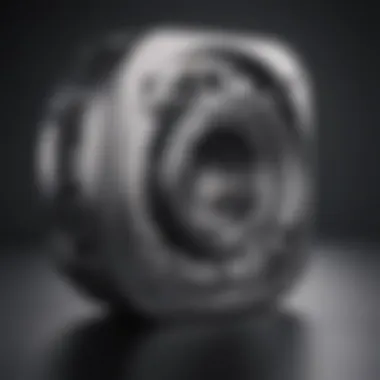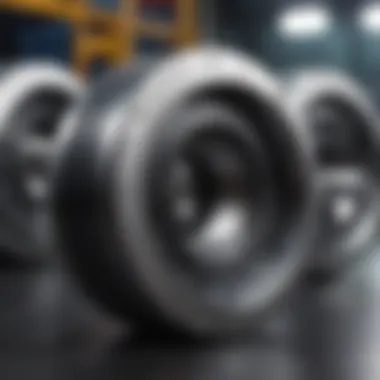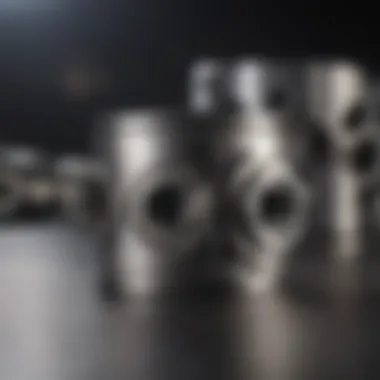Exploring the Technical Details of Volvo B20 Pistons


Intro
Volvo B20 pistons play a pivotal role within the realm of automotive engineering, particularly for enthusiasts who cherish both performance and reliability. This article will unpack the significance of these components, detailing everything from specifications to installation practices, while also advising on upgrade possibilities. We'll further examine how these pistons fit into the landscape of not just Volvo's engineering marvels, but within the larger automotive industry context.
Let's dive into the intricacies of the Volvo B20 pistons, providing you not just with raw data but insights that could save you time and money in your quest for optimal engine performance.
Foreword to Volvo B20 Pistons
The Volvo B20 engine has carved its niche in the world of automotive engineering, and at its core are the pistons that play a pivotal role in determining the overall performance of the engine. Pistons are not just metal components; they are the heart and soul of the engine, converting pressure from combustion into mechanical energy that powers the vehicle forward. Understanding the intricacies of Volvo B20 pistons is essential for anyone looking to delve deeper into automotive mechanics or for those considering upgrades or replacements.
Overview of the Volvo B20 Engine
The Volvo B20 engine, introduced in the late 1960s, is a testament to Volvo's commitment to quality and performance. This four-cylinder, overhead cam engine was designed with reliability in mind, offering ample torque and decent horsepower for a variety of applications.
Key characteristics that define the B20 engine include its robust construction and innovation in fuel efficiency. While it may not compete in raw horsepower figures with modern engines, its reputation for longevity and ease of maintenance has earned it a loyal following. Its configuration allows for a smooth power delivery, making it a surprisingly flexible option for both daily driving and motorsport use.
Pistons in this engine are crafted to withstand significant pressure and heat, showcasing Volvo's engineering prowess. With a displacement of around 2.0 liters, the B20's performance is enhanced by how well its pistons are designed and manufactured.
Importance of Pistons in Engine Functioning
Pistons serve a vital function, acting as the key interface in the combustion process. This process consists of a series of events occurring within the engine's cylinders, converting fuel into energy. Here's why pistons matter:
- Power Generation: They push down against the crankshaft, generating the rotating force needed to move the car.
- Compression Control: The pistons create a seal that helps maintain the necessary compression within the cylinder. This is critical for the engine to operate efficiently.
- Heat Management: Pistons help in distributing and dissipating heat, ensuring the engine runs within safe temperature limits.
"Without properly functioning pistons, even the best-designed engine can falter, leading to performance losses and potential damage."
Ultimately, in the realm of the Volvo B20, when considering upgrades or replacements, the choice and quality of the pistons can hugely influence engine longevity and performance. Whether you’re a seasoned mechanic or an automotive enthusiast looking to uplift your B20 experience, understanding the pistons is a leap toward enhancing your vehicle.
Specifications of Volvo B20 Pistons
Understanding the specifications of Volvo B20 pistons is fundamental for anyone looking to work with these engine components. The specifications give insights into how these pistons fit into the larger framework of engine performance and longevity. They are critical not just for enthusiasts but also for professionals who want to optimize the B20 engine’s functionality.
When it comes to specifications, some elements are particularly noteworthy:
- Material Composition: The type of materials used has a direct bearing on durability and thermal efficiency.
- Dimensions and Weight: The physical size and weight of the pistons affect their performance characteristics.
- Compression Ratios: This parameter plays a crucial role in the engine's overall power output and efficiency.
By diving deep into these specifications, one can unearth how the Volvo B20 pistons can be both reliable and potent, setting a standard in their class.
Material Composition
The material composition of the Volvo B20 pistons contributes significantly to their efficiency and performance. Typically made from an alloy of aluminum, these pistons are designed for strength without added weight. The alloy formulation is tailored to withstand the intense heat and pressure that occurs during combustion. One popular alloy used is aluminum-silicon. It’s known for its excellent casting characteristics and resistance to thermal expansion, which means it can maintain its shape even under duress.
Moreover, the piston’s surface may be anodized or coated with special materials to reduce friction and improve heat dissipation. This consideration ensures the longevity of the piston and its better interaction with cylinder walls.
Dimensions and Weight


The dimensions and weight of Volvo B20 pistons have a profound effect on engine dynamics. Generally, the pistons are designed to fit snugly within the cylinder bores, which are crucial for optimal power generation. The average diameter of a B20 piston hovers around 86mm, which makes it a suitable choice for various performance applications.
Weight comes into play, too. Lighter pistons can enhance engine responsiveness, leading to quicker acceleration. However, maintaining some weight is important to resist the high forces they encounter during operation. The careful balance in size and weight can make or break engine efficiency.
Compression Ratios
Compression ratios are a pivotal aspect that dictates how an engine breathes and performs. For the B20 engine, the standard compression ratio sits around 9:1, but this can vary depending on modifications and upgrades. A higher compression ratio usually translates to more power because it allows for more efficiency during combustion.
However, it is important to note that increasing this ratio might require using higher-octane fuel to avoid knocking. Thus, tuning into the right compression ratio isn’t just a technical detail; it's a marriage of chemistry, physics, and engineering expertise.
"Choosing the right piston specifications can mean the difference between an engine that purrs like a kitten and one that sputters at the starting line."
By honing in on these aspects of the Volvo B20 pistons, drivers and enthusiasts alike can better understand the nuances of performance and durability within their engines. The specifications serve as a roadmap to potential upgrades, essential for those wanting to take their Volvo B20 engines to the next level.
Performance Implications
When considering the overall functioning of the Volvo B20 engine, the performance implications of its pistons can't be brushed aside. Pistons are not just mere components; they serve as the engine's backbone, affecting efficiency, power output, and torque characteristics. Understanding how these intrinsic elements work together can make a world of difference for both seasoned mechanics and enthusiastic hobbyists alike.
Impact on Engine Efficiency
Pistons in the Volvo B20 engine play a critical role in determining how efficiently fuel is burned. Specifically, the design and sealing of the pistons influence the combustion process. A well-fitting piston allows for optimal compression, which is essential in maximizing power while minimizing fuel consumption.
- Compression Ratio: Higher compression ratios generally lead to better efficiency as they extract more energy from the fuel. However, there’s a balancing act since too much compression may lead to knocking, harming performance.
- Piston Material: With advancements in materials, aftermarket pistons often provide better thermal conductivity. This means that they dissipate heat effectively, thus promoting engine longevity and performance.
- Clearance: Adequate clearance between the piston and the cylinder wall ensures that oil can lubricate effectively. An improperly sized piston can lead to increased friction, which affects fuel economy.
One must keep in mind that even though improvements in piston technology may promise gains in efficiency, they come with considerations such as cost and compatibility with existing engine components.
Role in Power Output and Torque
Moving on to power output and torque, the relationship between a piston and these parameters is quite significant. Every time the piston moves up and down, it contributes to the rotational force that ultimately drives the vehicle’s wheels.
- Design Influences: The shape and weight of the piston impact how quickly it can accelerate during its cycle. A lighter piston can typically rev faster, which can lead to a snappier throttle response. On the other hand, heavier pistons might provide more stability at higher RPMs but can slow down acceleration.
- Combustion Dynamics: Pistons with improved designs can facilitate better airflow and fuel mixture, leading to more effective combustion. A well-crafted piston can mean the difference between a car feeling sluggish or responding eagerly when the driver steps on the gas.
- Torque Delivery: The piston also plays a vital part in torque delivery across the engine's RPM range. Different designs can optimize the power band, allowing for substantial torque production at desirable RPMs, thus enhancing overall drivability.
A well-selected piston can drastically improve both engine performance and driver satisfaction.
Ending
In summary, the performance implications tied to Volvo B20 pistons extend well beyond basic engine function. Their design, material, and overall integration within the engine affect not only efficiency but also the power output and torque delivery. Whether one is looking to rebuild an old engine or considering an upgrade, understanding these elements can lead to more informed decisions and better vehicle performance. Engaging with aftermarket options while keeping compatibility and requirements in mind allows enthusiasts to harness the full potential of the Volvo B20 engine.
Installation Process for Volvo B20 Pistons
Understanding the installation process for Volvo B20 pistons is crucial for both performance enthusiasts and casual car owners alike. This process directly impacts engine functionality, efficiency, and longevity. Proper installation ensures that the engine runs smoothly, avoids premature wear and tear, and enables any performance upgrades to take full effect. A poorly executed installation can lead to significant engine issues down the line, often resulting in costly repairs and headaches. Thus, having a detailed knowledge of the installation process not only equips you with the skill to carry out the task yourself but also provides insights into how pistons function harmoniously within the engine.
Necessary Tools and Equipment
Before diving into the installation process, it is essential to gather all the tools and equipment needed. Here’s a rundown of what’s typically required:
- Socket set – A comprehensive set will help with various bolt sizes.
- Torque wrench – Ensures bolts are tightened to the manufacturer’s specifications.
- Piston ring compressor – A handy tool to fit the piston rings into the cylinder without damaging them.
- Gasket scraper – For removing old gasket material cleanly.
- Oil – Engine oil for lubricating components during installation.
- Clean rags – For wiping down surfaces and cleaning messes.
- Engine assembly lube – To properly lubricate parts before reassembly.


Step-by-Step Installation Guide
The installation of Volvo B20 pistons can seem daunting, but by following a structured guide, it can be a straightforward process. Here’s how to go about it:
- Preparation: Begin by disconnecting the battery and draining the engine oil. It’s vital to work in a clean area to prevent dirt entering the engine.
- Remove Cylinder Head: Carefully detach the cylinder head. Keep track of all parts and bolts for a smooth reassembly.
- Remove Old Pistons: Unbolt the connecting rods and gently remove the old pistons, taking care to avoid scratching the cylinder walls.
- Clean the Engine Block: Use a gasket scraper to remove any remnants of old gaskets, ensuring a flat surface.
- Check Cylinder Walls: Inspect the cylinder walls for damage or scoring. If everything looks good, you can move on.
- Install New Rings: Fit new piston rings onto the new pistons. A piston ring compressor can be useful for this task to keep them from expanding until they're in the cylinder.
- Lubricate Components: Apply engine assembly lube to the piston and cylinder walls. This helps prevent damage during the initial start.
- Insert New Pistons: Carefully slide the new pistons into the cylinder, ensuring they are oriented correctly.
- Reconnect Connecting Rods: Bolting the connecting rods back in place is important. Ensure to torque them to the manufacturer’s specifications.
- Reinstall Cylinder Head: Finally, replace the cylinder head and ensure everything is tightened properly before reassembling other components.
Common Challenges and Solutions
While the steps to install Volvo B20 pistons may seem straightforward, several common challenges can arise:
- Difficult Piston Installation: Sometimes, pistons may not fit easily into the cylinders. Using a piston ring compressor can alleviate this issue.
- Difficulty in Sealing: If an old gasket material is leftover or not cleaned correctly, it may cause oil leaks. Always ensure surfaces are clean and even.
- Misalignment: Improper alignment of pistons can lead to serious engine damage. Always double-check positioning before final installation.
Tip: Don’t rush through the installation; take time to do it right, ensuring that all components are aligned and torqued correctly. This preventive measure can save you from a multitude of future headaches.
Being equipped with the right knowledge, and tools, and a bit of patience makes the installation of Volvo B20 pistons a rewarding endeavor. By understanding each step and addressing challenges methodically, you can contribute to the enhanced performance of your engine.
Aftermarket Options for Volvo B20 Pistons
Considering aftermarket options is a pivotal aspect of optimizing the performance and longevity of Volvo B20 pistons. When it comes to enhancing your engine's capabilities, aftermarket solutions provide various benefits that might not be possible with factory parts alone. Whether it’s for enthusiasts aiming for increased horsepower, better torque, or simply a need for a more durable part, understanding these alternatives can make a significant difference in performance.
Performance Upgrade Possibilities
Aftermarket pistons often present a golden opportunity for performance upgrades, allowing drivers to breathe new life into their B20 engines. Many of these options come equipped with advanced engineering, enhancing both efficiency and power output. Here are some performance upgrade possibilities to consider:
- Lightweight Materials: Many aftermarket pistons utilize lighter alloys or specialized composites. This helps to reduce inertia, allowing the engine to rev more freely and improving throttle response.
- Higher Compression Ratios: A number of aftermarket manufacturers offer pistons designed for higher compression ratios. This change can lead to significant gains in power, especially when paired with appropriate fuel and tuning.
- Enhanced Cooling Features: Some pistons are crafted with features that promote better heat dissipation. This can minimize the risk of engine knocking and extend the life of the piston under high-stress conditions.
By upgrading to performance-oriented pistons, drivers can transform the driving experience, turning a good engine into a great one.
Compatibility with Existing Engine Components
When opting for aftermarket pistons, it’s crucial to consider how well they play with your existing engine components. Not all pistons are created equal, and compatibility can dictate not only the performance but also the longevity of the build.
- Matching Piston Size and Type: Ensuring that the replacement pistons match the standard dimensions is paramount. Most aftermarket pistons are available in standard or oversized variants, so knowing your current piston size can prevent unnecessary issues.
- Connecting Rod Compatibility: Different aftermarket options might require specific connecting rod configurations or enhancements. It’s vital to confirm that the piston’s design works harmoniously with the rod and crankshaft.
- Consider Valve Clearance: Many high-performance pistons have altered shapes or heights that may affect the clearance with the engine valves. Here, a bit of extra research can pay dividends in avoiding costly adjustments.
Ultimately, selecting the right aftermarket pistons can not only fulfill the desire for better performance but also ensure a seamless integration with the original engine setup. Choosing wisely benefits both immediate results and the overall health of your engine.
Maintenance and Care
Maintaining the Volvo B20 pistons is crucial to ensuring the longevity and optimal performance of the engine. Just like the gears of a clock, every component in the Volvo B20 engine works in harmony, and pistons are central to that symphony. Regular maintenance can prevent small issues from snowballing into larger ones that could require expensive repairs. Furthermore, keeping things shipshape under the hood can also contribute to better fuel efficiency and overall performance. In this section, we’ll explore the routine checks that every driver should keep an eye on, along with signs indicating possible piston wear or damage.
Routine Checks and Services
Routine maintenance is a bit like brushing your teeth – cumbersome at times, but necessary for avoiding bigger problems down the road. Here are some practical checks that should be considered:
- Oil Quality: Regular oil changes are essential since oil lubricates not only the pistons but also the crankshaft and other moving parts. Old oil can deteriorate and form sludge, which might impair piston function.
- Coolant Levels: A good engine is a cool engine. Checking coolant levels and ensuring the cooling system is functioning prevents overheating, which can be catastrophic for pistons.
- Spark Plug Inspection: The health of the spark plugs is tied to piston performance. Worn or dirty spark plugs can lead to combustion issues, burdening the pistons in the process.
- Compression Tests: Performing periodic compression tests can give insight into the health of the pistons. A drop in compression levels might signal wear or damage.
By conducting these checks, drivers can catch any problems early before they develop into major issues.


Signs of Piston Wear or Damage
Pistons endure a lot of heat and pressure during their operation, making them susceptible to various forms of wear. Recognizing the signs of potential piston damage early can save a world of headaches later on. Here are some telltale indicators:
- Oil Consumption: If you find yourself needing to top off oil more often than usual, it might mean the piston rings are worn out, allowing oil to leak into the combustion chamber.
- Unusual Noises: Knocking, pinging, or clicking sounds from the engine can be a signal of piston trouble, including detonation or bearing issues.
- Engine Performance Changes: Reduced power, sluggish acceleration, or increased fuel consumption could indicate that pistons aren’t functioning properly. It’s like trying to run a race with a heavy backpack.
- Exhaust Smoke: Blue smoke from the exhaust can indicate that oil is burning in the cylinder due to worn piston rings.
Remember: Paying attention to your vehicle and addressing these signs promptly can extend the life of your engine significantly.
By integrating these maintenance practices into your routine, you not only secure the reliability of the Volvo B20 but also enrich your driving experience. Keeping a keen eye on the piston's condition can yield performances that would put a smile on any car enthusiast’s face.
Volvo B20 Pistons in the Larger Context of Automotive Engineering
Understanding Volvo B20 pistons requires a look beyond just the part itself. They are a reflection of automotive engineering's evolutionary journey, welcoming innovations and changes that have influenced how we think about engines today. The B20 engine, a solid piece of engineering from Volvo, showcases the intricate relationship between piston design, fuel efficiency, and vehicle performance.
Evolution of Engine Technology
The roots of engine technology run deep, stretching back over a century. In the early days, engines like those found in the Model T were comprised primarily of simple, straightforward designs. Fast forward to today, and the evolution is striking.
Engineers are working tirelessly with materials science, obtaining lighter weights without sacrificing strength. This constant search is what brought us pistons crafted from various alloys, improving thermal resistance and performance. For instance, the material used in the B20 pistons greatly impacts how effectively they endure extreme temperatures and pressure fluctuations.
Seemingly trivial advancements like changing the piston skirt design or altering the shape have monumental implications on engine performance. These enhancements lead to smoother operations and reduced friction, contributing immensely to fuel economy and emissions. The move towards integrating computer-aided design (CAD) allowed engineers to simulate and evaluate performance in a virtual environment before physical prototypes—something unheard of in the early decades.
B20 Pistons Compared to Other Engine Designs
Comparing B20 pistons to those used in other engines—whether from other Volvo models or competing manufacturers—offers unique insights into automotive engineering.
- Piston Size and Weight: The B20 pistons are generally heavier relative to smaller engines, but they compensate by supporting a higher displacement, which translates to more power.
- Compression Ratio Varieties: Unlike some engines that have stagnant compression ratios across their production, the B20 series varies its designs to yield distinct performance traits, especially in tuning and racing applications.
- Aftermarket Upgrades: Some piston designs in other engines facilitate an easier path for performance upgrades, while B20's intricate specifications can pose both challenges and opportunities for those interested in enhancing their vehicle.
In broad strokes, the Volvo B20 pistons are a testament to the shifting landscape of engine technology, embodying a blend of durability, innovation, and specific design considerations that keep these pieces of hardware relevant in motorsports and daily driving.
"The evolution of pistons signifies the strides made toward efficiency and performance, crafting a narrative that intertwines raw power with engineering finesse."
Whether you are a seasoned enthusiast, a casual driver, or simply someone intrigued by the mechanics of automobiles, the significance of Volvo B20 pistons can scarcely be overstated. Their importance lies not just in their individual performance but in the larger narrative of automotive progress.
Ending
In summation, the journey through the various aspects of Volvo B20 pistons underscores their crucial role in optimizing engine performance and reliability. These pistons are not simply components; they act as key players in the intricate ballet of function and efficiency within the engine. Having delved deep into their specifications, performance implications, and installation processes, it’s apparent that understanding how to approach these elements can lead to better choices when it comes to modifications and repairs.
Summary of Key Insights
The exploration of Volvo B20 pistons reveals several significant points:
- Critical Role: Pistons are fundamental to how an engine operates. Their design affects power delivery, efficiency, and longevity.
- Material and Design: The composition and dimensions play a vital role in performance. Modern aftermarket options provide room for enhancements that can improve power output.
- Installation Importance: A well-executed installation process can prevent future complications and enhance overall vehicle performance.
- Maintenance is Key: Routine checks are essential. Recognizing the early signs of wear can save car owners from more extensive damage and repair costs later on.
Each of these points contributes to the understanding of how Volvo B20 pistons can elevate the engine's functionality and save on potential future expenses.
Final Thoughts on Upgrading Volvo B20 Pistons
Upgrading the Volvo B20 pistons can often yield impressive results, both in terms of performance and efficiency. However, enthusiasts and car owners should approach this decision with careful consideration. It's not just about buying parts; it's about ensuring compatibility with the existing setup and understanding how changes in one part affect the entire engine.
- Assess Application: Evaluate whether the upgrade aligns with your intended use of the vehicle—whether it’s for spirited driving, daily commuting, or competitive motorsports.
- Research Thoroughly: Before making a purchase, investigate various options and read reviews from users who have completed similar upgrades.
- Consult Professionals: If uncertain, don't hesitate to engage with experienced mechanics or specialists who can provide tailored advice based on your specific car setup.
In the world of automotive engineering, knowledge is as valuable as having the best parts. To navigate the complexities of upgrading Volvo B20 pistons is to unlock the potential of your beloved car, crafting a blend of performance, reliability, and enjoyment on the road.







